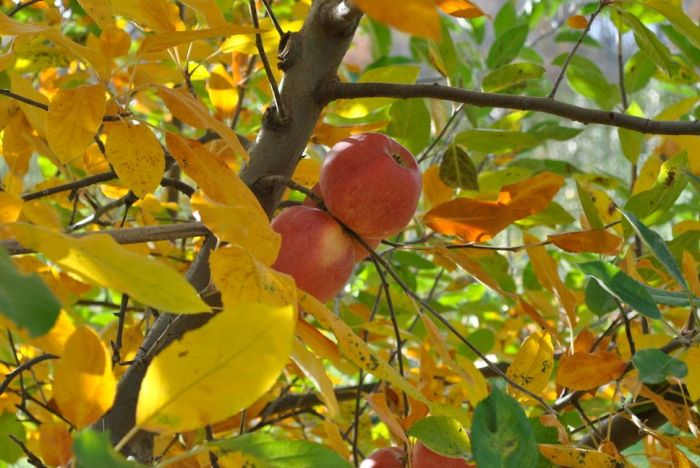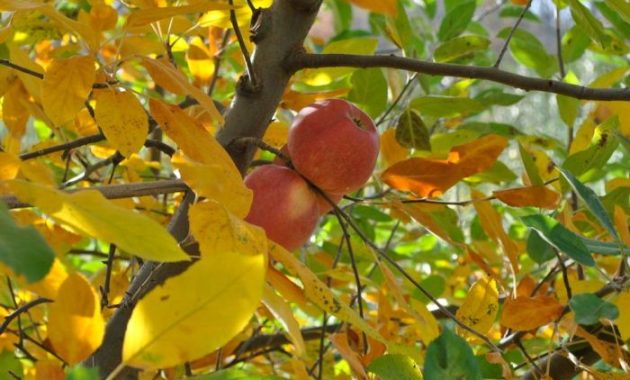Post-Planting Care: Fruit Trees To Plant In Fall

Fruit trees to plant in fall – Right, so you’ve planted your fruit trees, mega kudos! Now’s the time to give them some proper TLC to make sure they thrive. Basically, you’re setting them up for a banging harvest in the years to come, innit? Get this bit wrong and you’ll be gutted.Watering newly planted fruit trees in autumn and winter is all about getting the balance right.
You don’t want them drowning, but equally, they need enough moisture to settle in properly and avoid drying out completely. Overwatering can rot the roots, while underwatering stresses the tree and makes it vulnerable to pests and diseases. It’s a proper juggling act.
Fall’s the perfect time to get your hands dirty planting fruit trees, ensuring a bountiful harvest next year. But beyond apples and pears, consider diversifying your landscape; for a striking, low-maintenance addition, check out the vibrant blooms of the bottle brush tree plant , though it’s not a fruit tree, it adds a beautiful contrast. Back to those fruit trees – don’t forget to choose varieties suited to your climate!
Watering Newly Planted Fruit Trees, Fruit trees to plant in fall
Deep, infrequent watering is the way to go. Instead of frequent shallow watering, aim for a thorough soaking of the root ball once a week, or less if the weather is wet. Check the soil moisture regularly – stick your finger a couple of inches into the soil; if it feels dry, it’s time to water. During milder spells, you might need to water more often, but avoid watering if the ground is already waterlogged.
A good soak will encourage deeper root growth, which is essential for a healthy, drought-resistant tree. Think of it like giving them a proper refreshing drink, not just a quick sip.
Mulching Newly Planted Fruit Trees
Mulching is, like, seriously important. Think of it as a cosy blanket for your tree’s roots. A good layer (around 2-3 inches) of organic mulch, such as wood chips, straw, or shredded bark, helps to retain moisture, suppress weeds, regulate soil temperature, and improve soil structure over time. It’s a proper win-win situation. Plus, it keeps the area looking tidy, which is always a bonus.
Avoid piling mulch directly against the tree trunk, though, as this can lead to rot.
Potential Pests and Diseases
Young fruit trees are pretty vulnerable to all sorts of nasties. Keeping an eye out for common problems is key to preventing bigger issues later.
- Aphids: These little blighters suck sap from leaves and shoots, weakening the tree. Regularly inspect your trees, and use a strong jet of water to blast them off or introduce beneficial insects like ladybirds that munch on them.
- Apple scab: A fungal disease causing dark, scabby spots on leaves and fruit. Good air circulation helps prevent this, so avoid overcrowding your trees. Removing fallen leaves in autumn also helps reduce the spread of the disease.
- Woolly aphids: These leave white, woolly masses on branches. Again, regular inspection is key, and you can manually remove them with a brush or use an insecticidal soap.
- Codling moth: These pesky insects bore into apples and other fruits, leaving behind damage and grubs. You can use pheromone traps to monitor their presence and reduce their numbers.
Regular inspections are crucial. Early detection and prompt action are your best weapons against these pests and diseases. Think of it like a regular health check-up for your trees – better to catch things early than deal with a major problem later.
Choosing the Right Location

Right, so you’ve got your lil’ fruit tree saplings, dead chuffed, yeah? But before you chuck ’em in the first bit of soil you see, you need to be proper savvy about where you plonk ’em. Getting the location right is mega important for a bumper harvest, innit? Think of it like finding the perfect spot for a banging summer BBQ – you wouldn’t do it in the shade, would ya?Picking the right spot for your fruit trees is all about giving them the best chance to thrive.
We’re talking sunshine, shelter from the wind, and easy access to water. Get it wrong, and you’ll be gutted when your trees are all stunted and struggling. Plus, you need to think about how big they’re gonna get – you don’t want a massive apple tree overshadowing your entire garden, do you?
Sunlight Requirements
Fruit trees are proper sun worshippers, needing at least six hours of direct sunlight a day to properly photosynthesise and produce fruit. Less than that, and you’ll end up with a miserable, unproductive tree. Think south-facing spots are your best bet, especially in the UK where we don’t exactly get bathed in sunshine all year round. Consider any existing structures or other plants that might cast shadows.
A south-facing wall can be a great spot for some trees, providing extra warmth and protection.
Wind Protection and Water Access
Wind can be a right pain, causing damage to branches and drying out the soil. Try to find a spot that’s sheltered from strong winds, maybe near a wall or hedge. And don’t forget about water – you don’t want to be lugging watering cans across the garden every day. Planting near a water source like a tap or a rain-collecting barrel will make life so much easier.
Mature Tree Size and Spacing
This is a massive one. You need to think about how big your trees will get when they’re fully grown. Cramming them together is a recipe for disaster. They’ll compete for sunlight, water, and nutrients, resulting in smaller fruit and weaker trees.
Ideal Spacing for Various Fruit Tree Types
Imagine a grid system, showing the space each tree needs. For example:Imagine a grid where each square represents a metre.* Apple Trees: These can get massive, so you’ll need a good 4-5 metre spacing between trees. Think a 4×4 metre grid square for each.
Plum Trees
Slightly smaller than apples, but still need around 3-4 metres of space. A 3×3 metre grid square would work well.
Cherry Trees
These are usually smaller again, needing about 2-3 metres of space. A 2×2 metre grid square.
Bush Fruit (Raspberries, Blackberries)
These are much smaller and can be planted closer together, but still need space to spread. Maybe 1-1.5 metres between plants.This is just a rough guide, obviously. Always check the specific variety you’re planting, as sizes can vary. You’ll find this info on the plant label or from the supplier. Proper research is key, bruv!
FAQ Insights
What are the signs of a healthy fruit tree sapling after planting?
Healthy saplings will show strong, upright growth, vibrant green leaves (if planted in spring/summer), and firm, unblemished bark. Look for signs of new growth in the spring following planting.
How often should I water newly planted fruit trees in the fall?
Water deeply and less frequently. Aim for thorough soaking, especially during dry spells, but avoid overwatering which can lead to root rot. The frequency depends on rainfall; check soil moisture regularly.
Can I plant fruit trees in containers in the fall?
Yes, container-grown trees can be planted in the fall. However, ensure the container is appropriately sized and the root ball is not overly dry before planting.
When should I prune my newly planted fruit trees?
Generally, significant pruning is best avoided the first year after planting. Focus on removing any damaged or diseased branches. More substantial pruning can be done in late winter or early spring.

